Written by Bhagwati Prasad Semwal VU3BPZ-8T2BH
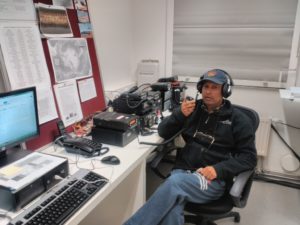 Antarctic Epic did start long ago with no way to communicate from Antarctica to the rest of the world, then Guglielmo Marconi, an Italian inventor and electrical engineer, known for his pioneering work on long-distance radio transmission and for his development of radio telegraph system, show the world the power of Radio transmission.
Antarctic Epic did start long ago with no way to communicate from Antarctica to the rest of the world, then Guglielmo Marconi, an Italian inventor and electrical engineer, known for his pioneering work on long-distance radio transmission and for his development of radio telegraph system, show the world the power of Radio transmission.
Later one after WW1 & WW2 the Nations signed the Antarctic Treaty and the Antarctic Adventure begun. From that time, in the 50thies, the Radio was the unique way to be in touch from the newly built Antarctic Research Stations and therest of the world.
From that time, being a licensed Radio Amateur was a privilege of few technicians involved in the Antarctic Campaigns and being Radio Amateur, they were mostly communication officers. After the commercial duties and communication with their country’s Antarctic Departments, they had time to use the Base Equipments to talk to the family using other Ham fellows with Phone Patch to talk to their families, and to other Ham radio men, all over the world.
A new era did start: DX with Antarctica and yes, a contact using a simple Radio transceiver from Antarctica to the rest of the world was, and is still amazing. The interest did grow fast and became a fever, a real excitement a real passion.
At that time every Antarctic Base, every Refuge, every remote camp was equipped with Transceiver for HF communications, antenna, generator or other power supply sources.
Most of the Bases did install big towers and rotary antenna system, using amplifiers to allow more chance to send robust signals on the air. On the other side, the worldwide Ham community, hunting contacts with Antarctica, did the same; all involved in a kind of passion for the so called very long distance call, known as DX.
 QSL confirmation for a contact with an Antarctic Station was, and still is something to exhibit. On the meantime the first websites dedicated to the Antarctic Chasers did start to be online, as for example WAP-Worldwide Antarctic Program www.waponline.it since 1979. On it several features such as the most accurate Dbase (WAP-WADA) of Antarctic Stations, Remote Camps, Refuges, Huts and permanent settlements sorted by Country, Lat & Long and exact location.
QSL confirmation for a contact with an Antarctic Station was, and still is something to exhibit. On the meantime the first websites dedicated to the Antarctic Chasers did start to be online, as for example WAP-Worldwide Antarctic Program www.waponline.it since 1979. On it several features such as the most accurate Dbase (WAP-WADA) of Antarctic Stations, Remote Camps, Refuges, Huts and permanent settlements sorted by Country, Lat & Long and exact location.
Another huge Dbase (WAP-WACA) has been built; it lists over 4500 different callsigns in use or used in the past in Antarctica, Sub & Peri Antarctic areas, all available for free on line.
Time goes fast and we did enter quickly in the era of Internet. Very few young boys are still excited or fascinated by Ham radio, even if in Antarctica HF & VHF communications are still important and very much used to keep and establish contacts with remote field camps, with the researchers working outside, and with the helicopters or aircrafts to the main Stations or Bases.
Radio is probably considered by the young generation somewhat obsolete, something surpassed, something out of fashion … nothing could be more wrong! Radio remains a safe option in case of emergency, when internet black out, when other communication devises may fail, the radio remains, it does not need repeaters, as the radio waves propagate in space!
HF transmissions are therefore subjected to the Propagation condition which is influenced by the solar activity and in particular periods of the year, operators must know the MUF (Maximum Usable Frequency) and check Propagation Prediction tables in order to know when and in which direction looking for to make some possible contacts
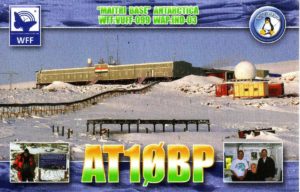 Bhagwati Prasad Semwal is a good experienced Ham Radio Operator, licensed as VU3BPZ, and operating from Antarctica since 2001. Bagwati Prasad (Ex-20,24,29th, Maitri & 31th,Bharati, WOT )has been active from several Antarctic sites as VU3BPZ/P, VU3BPZ/RI1, AT1ØBP, VU3BPZ/MM and actually he is part of the 35th ISEA (2015-2016) based at Bharati Station (69°S, 076°E), Larsemann Hills, Antarctica where he operates as 8T2BH.
Bhagwati Prasad Semwal is a good experienced Ham Radio Operator, licensed as VU3BPZ, and operating from Antarctica since 2001. Bagwati Prasad (Ex-20,24,29th, Maitri & 31th,Bharati, WOT )has been active from several Antarctic sites as VU3BPZ/P, VU3BPZ/RI1, AT1ØBP, VU3BPZ/MM and actually he is part of the 35th ISEA (2015-2016) based at Bharati Station (69°S, 076°E), Larsemann Hills, Antarctica where he operates as 8T2BH.
Worldwide Ham Radio Community is grateful to the Indian Antarctic Dept. for putting licensed Ham radio operators among the Teams overwintering in Antarctica; India did a real great job with the Hams involved in Antarctica up to now; a mention has to be given to:
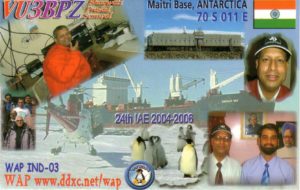 ATØA operating from Daskshin Gangotry Base in the 8Øties, AT3D, VU3HKQ, VU2AXA, VU2JBK, VU3RAY, VU2DMT who have been active from Maitri Base, Indian Bay and Bharati Stations giving a huge number of Antarctic chasers worldwide, a chance to log all the 3 main Indian Scientific Stations in their log with different callsigns.
ATØA operating from Daskshin Gangotry Base in the 8Øties, AT3D, VU3HKQ, VU2AXA, VU2JBK, VU3RAY, VU2DMT who have been active from Maitri Base, Indian Bay and Bharati Stations giving a huge number of Antarctic chasers worldwide, a chance to log all the 3 main Indian Scientific Stations in their log with different callsigns.
Actually propagation is not in a good shape; solar flux, sunspot and A index are at a low level, but taking care of the rare openings on different bands, is possible to establish good contacts with a range of 10-15.000 km.
What is actually missed in the Indian Bases is a rotating Log periodic beam antenna, able to cover all HF bands in case of internet black out or emergency, a liner amplifier in order to ensure a robust signal in case of lack of propagation.
In addition another tool is available for Hams, and that is the VOACAP Prediction available online at:
http://www.voacap.com/prediction.html .
This web site gives an idea to a Radio operator which band of the HF Band plan is the best one to be used and percentage of chances to make good contacts. Actually conditions are very low and infact just the bands from 18 to 24 MHz offer 40% of possibility to make contacts.
During the 35th Indian Antarctic Scientific Expedition (2015-2016) we did a lot of propagation testing on different bands from 10 mts through 40 mts SSB and we noticed a very fast changing conditions and so far only about 100 QSOs have been made as 8T2BH from Bharati Station, even if with 15 different Countries. Nothing to compare with 2011-2012’s season when the QSOs made were over 1000, or from Maitri Station where conditions were so much favorable.
Now it could be propagation will change, no more Auroras or magnetic storms which are causing terrific noise on the band. I hope to be able to keep uphold the Indian pride and using the privilege to be here in Antarctica for the 5th time as Ham Radio and Communication Officer to fulfill the many requests for QSOs by Radio amateurs operators around the world.
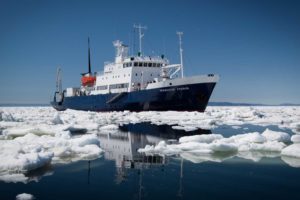 John wrote: -The 50-passenger M/V Spirit of Enderby is described as an ‘intimate’ exploration vessel with a reinforced hull. It apparently is pretty cramped and the bathroom is down the hall. The Captain and crew are Russian and I was advised to bring a potent surge protector .
John wrote: -The 50-passenger M/V Spirit of Enderby is described as an ‘intimate’ exploration vessel with a reinforced hull. It apparently is pretty cramped and the bathroom is down the hall. The Captain and crew are Russian and I was advised to bring a potent surge protector .
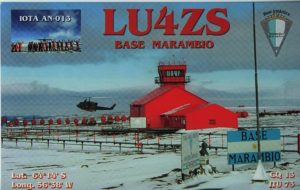 On last March 11, the Radio station LU4ZS at Base Marambio did start the 2016 Ham Activation, promoting the continuity of successful Radio-Amateur operation of the past 2013/14 Antarctic campaign, in which hundreds of Shortwave contacts were made worldwide. This year 2017, it has been planned to carry out another activation.
On last March 11, the Radio station LU4ZS at Base Marambio did start the 2016 Ham Activation, promoting the continuity of successful Radio-Amateur operation of the past 2013/14 Antarctic campaign, in which hundreds of Shortwave contacts were made worldwide. This year 2017, it has been planned to carry out another activation.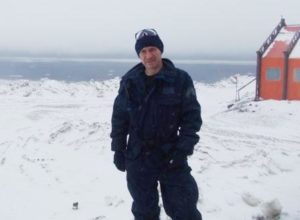

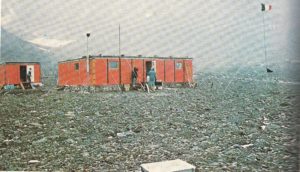 December 1975: 15 Italians did challenge the climatic conditions, economic difficulties and political inertia to build a Base in the coldest and inhospitable site of the planet, with temperatures that in the “hot” months reach 19 degrees below zero and during the long winter of the sub-southern hemisphere go down to -50°C. The Expedition arrives before the accession of Italy to the Antarctic Treaty, before the PNRA, the National Research Program at the South Pole.
December 1975: 15 Italians did challenge the climatic conditions, economic difficulties and political inertia to build a Base in the coldest and inhospitable site of the planet, with temperatures that in the “hot” months reach 19 degrees below zero and during the long winter of the sub-southern hemisphere go down to -50°C. The Expedition arrives before the accession of Italy to the Antarctic Treaty, before the PNRA, the National Research Program at the South Pole.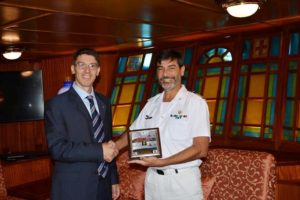 Everything else has disappeared in nothing” wrote Renato Cepparo in his memories.
Everything else has disappeared in nothing” wrote Renato Cepparo in his memories.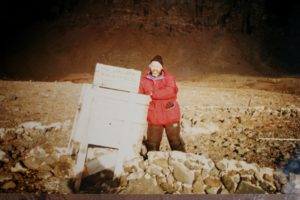 Stanislaw Miranski SP3BGD, send us a picture taken in April 1998. Here is the remains of Italian Antarctic Station “Giacomo Bove” – Italia Valley on King George island.
Stanislaw Miranski SP3BGD, send us a picture taken in April 1998. Here is the remains of Italian Antarctic Station “Giacomo Bove” – Italia Valley on King George island.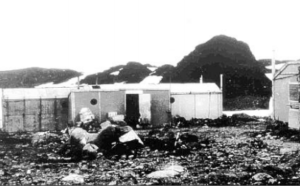 The Station with two buildings able to guest 8 people, was originally built by the Soviet Antarctic Expeditions the Oct. 16th 1956 and named Oazis then, on 23rd January 1959, it has been handed over to the Academy of Sciences of the Polish People’s Republic by the Soviet Academy. The Polish named it Dobrowolski Station in memory of Antoni B. Dobrowolski (1872-1954), geophysicist and glaciologist, who participated in the Belgica Antarctic Expedition (1877-79).
The Station with two buildings able to guest 8 people, was originally built by the Soviet Antarctic Expeditions the Oct. 16th 1956 and named Oazis then, on 23rd January 1959, it has been handed over to the Academy of Sciences of the Polish People’s Republic by the Soviet Academy. The Polish named it Dobrowolski Station in memory of Antoni B. Dobrowolski (1872-1954), geophysicist and glaciologist, who participated in the Belgica Antarctic Expedition (1877-79). 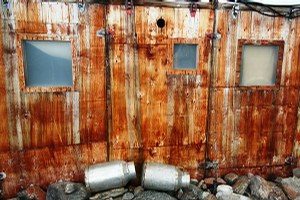
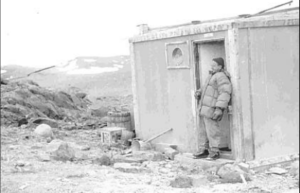 The Soviet Union became interested in the Bunger Hills again in the late 1980s, and built a new station – Oazis-2 – a few hundred meters to the west of Dobrowolski. The station was used for summer visits up to the mid-1990s (Bunger Oasis Station WAP RUS-NEW)
The Soviet Union became interested in the Bunger Hills again in the late 1980s, and built a new station – Oazis-2 – a few hundred meters to the west of Dobrowolski. The station was used for summer visits up to the mid-1990s (Bunger Oasis Station WAP RUS-NEW) Felix Riess (DL5XL) has been active as DP1POL/p for a short period of time from the Russian Station Novolazarevskaya (WAP RUS-Ø9) while waiting the ALCI flight from Novo Runway (WAP MNB-Ø6) to Cape Town.
Felix Riess (DL5XL) has been active as DP1POL/p for a short period of time from the Russian Station Novolazarevskaya (WAP RUS-Ø9) while waiting the ALCI flight from Novo Runway (WAP MNB-Ø6) to Cape Town.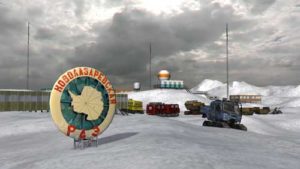
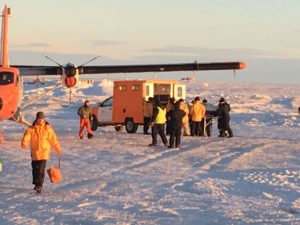 In an unprecedented operation, the Argentinean Armed Forces planned a medical evacuation of the second officer, electrician Héctor Bulacio, from the Orcadas Base to the hospital in Ushuaia. The 38-year-old man was in danger if thye did not move him; he had suffered fractures in his legs. A Rescue by sea was impossible because in winter time the Base is surrounded by 110 kilometers of ice field.
In an unprecedented operation, the Argentinean Armed Forces planned a medical evacuation of the second officer, electrician Héctor Bulacio, from the Orcadas Base to the hospital in Ushuaia. The 38-year-old man was in danger if thye did not move him; he had suffered fractures in his legs. A Rescue by sea was impossible because in winter time the Base is surrounded by 110 kilometers of ice field. Antarctic Epic did start long ago with no way to communicate from Antarctica to the rest of the world, then Guglielmo Marconi, an Italian inventor and electrical engineer, known for his pioneering work on long-distance radio transmission and for his development of radio telegraph system, show the world the power of Radio transmission.
Antarctic Epic did start long ago with no way to communicate from Antarctica to the rest of the world, then Guglielmo Marconi, an Italian inventor and electrical engineer, known for his pioneering work on long-distance radio transmission and for his development of radio telegraph system, show the world the power of Radio transmission. QSL confirmation for a contact with an Antarctic Station was, and still is something to exhibit. On the meantime the first websites dedicated to the Antarctic Chasers did start to be online, as for example WAP-Worldwide Antarctic Program
QSL confirmation for a contact with an Antarctic Station was, and still is something to exhibit. On the meantime the first websites dedicated to the Antarctic Chasers did start to be online, as for example WAP-Worldwide Antarctic Program  Bhagwati Prasad Semwal is a good experienced Ham Radio Operator, licensed as VU3BPZ, and operating from Antarctica since 2001. Bagwati Prasad (Ex-20,24,29th, Maitri & 31th,Bharati, WOT )has been active from several Antarctic sites as VU3BPZ/P, VU3BPZ/RI1, AT1ØBP, VU3BPZ/MM and actually he is part of the 35th ISEA (2015-2016) based at Bharati Station (69°S, 076°E), Larsemann Hills, Antarctica where he operates as 8T2BH.
Bhagwati Prasad Semwal is a good experienced Ham Radio Operator, licensed as VU3BPZ, and operating from Antarctica since 2001. Bagwati Prasad (Ex-20,24,29th, Maitri & 31th,Bharati, WOT )has been active from several Antarctic sites as VU3BPZ/P, VU3BPZ/RI1, AT1ØBP, VU3BPZ/MM and actually he is part of the 35th ISEA (2015-2016) based at Bharati Station (69°S, 076°E), Larsemann Hills, Antarctica where he operates as 8T2BH. ATØA operating from Daskshin Gangotry Base in the 8Øties, AT3D, VU3HKQ, VU2AXA, VU2JBK, VU3RAY, VU2DMT who have been active from Maitri Base, Indian Bay and Bharati Stations giving a huge number of Antarctic chasers worldwide, a chance to log all the 3 main Indian Scientific Stations in their log with different callsigns.
ATØA operating from Daskshin Gangotry Base in the 8Øties, AT3D, VU3HKQ, VU2AXA, VU2JBK, VU3RAY, VU2DMT who have been active from Maitri Base, Indian Bay and Bharati Stations giving a huge number of Antarctic chasers worldwide, a chance to log all the 3 main Indian Scientific Stations in their log with different callsigns.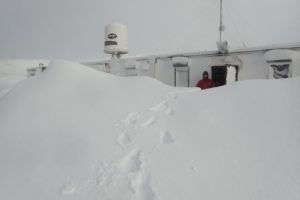 The station was established on 26 February 1977.
The station was established on 26 February 1977.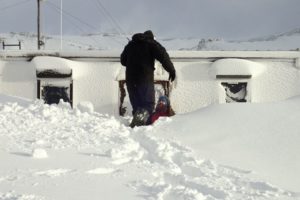
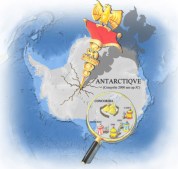 The sixteenth edition (release 1.30) of WAP WACA & WADA Directories are available to download. Just go to the “Download Section” and feel free to save them both on your PC.
The sixteenth edition (release 1.30) of WAP WACA & WADA Directories are available to download. Just go to the “Download Section” and feel free to save them both on your PC.
 The Antarctic Circumpolar Current is the only ocean current to circle the planet and the largest wind-driven current on Earth. It’s also 30% more powerful than scientists realized.
The Antarctic Circumpolar Current is the only ocean current to circle the planet and the largest wind-driven current on Earth. It’s also 30% more powerful than scientists realized. Felix Riess DL5XL (aka N5BC) is operating DP1POL callsign from Antarctica since 2002.
Felix Riess DL5XL (aka N5BC) is operating DP1POL callsign from Antarctica since 2002. PNRA (Italian National Research Program in Antarctica) via CNR and ENEA, is managing the Italian Bases in Antarctica. There is a call for journalists to participate the XXXIII Italian Expedition in Antarctica.
PNRA (Italian National Research Program in Antarctica) via CNR and ENEA, is managing the Italian Bases in Antarctica. There is a call for journalists to participate the XXXIII Italian Expedition in Antarctica.
 Alex Turkeev, RD1AV, the actual Chief and radio operator at the Russian Vostok Station is still overwintering at Vostok where he will remain till February 10, 2018.
Alex Turkeev, RD1AV, the actual Chief and radio operator at the Russian Vostok Station is still overwintering at Vostok where he will remain till February 10, 2018.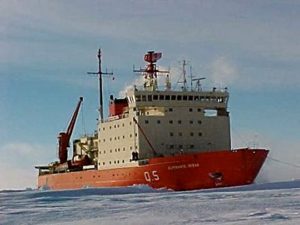 Argentina’s Navy icebreaker ARA Almirante Irizar is back on sea and next September will be ready to sail to Antarctica following almost ten years of recovery and refurbishing after she caught fire in 2007 when returning from Antarctica and was considered almost a wreck given the magnitude of the damages experienced.
Argentina’s Navy icebreaker ARA Almirante Irizar is back on sea and next September will be ready to sail to Antarctica following almost ten years of recovery and refurbishing after she caught fire in 2007 when returning from Antarctica and was considered almost a wreck given the magnitude of the damages experienced.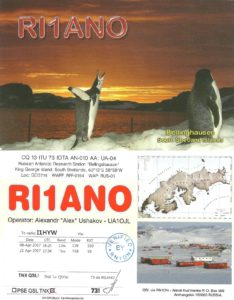 Another “new one” WACA in our Antarctic QSL collection and a WAP RUS-Ø1 for WADA
Another “new one” WACA in our Antarctic QSL collection and a WAP RUS-Ø1 for WADA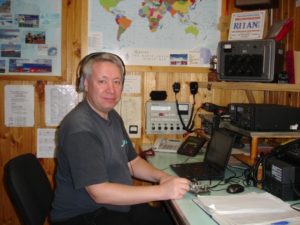
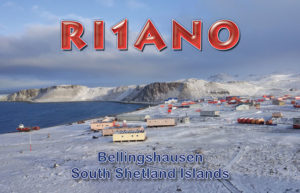
 The Antarctic Treaty Consultative Meeting (ATCM) is the annual meeting for all parties of the Antarctic Treaty to discuss pressing Antarctic issues. Only consultative parties – parties that have demonstrated their interest in Antarctica by ‘conducting substantial research activity there’ – are allowed to take part in decision-making processes. This is the first time that China hosts the ATCM, which attracted a lot of attention both within and outside China.
The Antarctic Treaty Consultative Meeting (ATCM) is the annual meeting for all parties of the Antarctic Treaty to discuss pressing Antarctic issues. Only consultative parties – parties that have demonstrated their interest in Antarctica by ‘conducting substantial research activity there’ – are allowed to take part in decision-making processes. This is the first time that China hosts the ATCM, which attracted a lot of attention both within and outside China.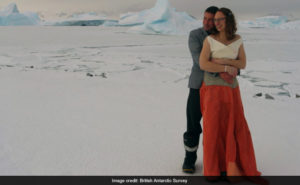 Polar field guides Julie Baum and Tom Sylvester got married in sub-zero temperatures in a two-day celebration.
Polar field guides Julie Baum and Tom Sylvester got married in sub-zero temperatures in a two-day celebration. Climate change will cause ice-free areas on Antarctica to increase by up to a quarter by 2100, threatening the diversity of the unique terrestrial plant and animal life that exists there, according to projections from the first study examining the question in detail. If emissions of greenhouse gasses are not reduced, projected warming and changes in snowfall will cause ice-free areas – which currently make up about 1% of Antarctica and are home to all of the continent’s terrestrial plants and animals – to increase by as much as 17,000 square kilometres.
Climate change will cause ice-free areas on Antarctica to increase by up to a quarter by 2100, threatening the diversity of the unique terrestrial plant and animal life that exists there, according to projections from the first study examining the question in detail. If emissions of greenhouse gasses are not reduced, projected warming and changes in snowfall will cause ice-free areas – which currently make up about 1% of Antarctica and are home to all of the continent’s terrestrial plants and animals – to increase by as much as 17,000 square kilometres. Ved Prakash Sandlas, VU2VP, destingushed Scientist & former Cheif controller R&D DRDO did pass away on 6th July 2017. He was good promoter of Ham radio & sent Ham Radio Rigs to Antarctica.
Ved Prakash Sandlas, VU2VP, destingushed Scientist & former Cheif controller R&D DRDO did pass away on 6th July 2017. He was good promoter of Ham radio & sent Ham Radio Rigs to Antarctica.
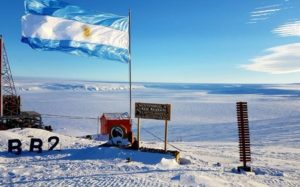
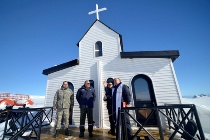 On Thursday 25 September 2014, the Commander in Chief of the IV Air Brigade, General Aviation Brigade Manuel Sainz Salas, did visit the Antarctic Air Base President Eduardo Frei Montalva and attended, with the Commander of the Air Base Group Commander (DA) Gonzalo Opazo, t
On Thursday 25 September 2014, the Commander in Chief of the IV Air Brigade, General Aviation Brigade Manuel Sainz Salas, did visit the Antarctic Air Base President Eduardo Frei Montalva and attended, with the Commander of the Air Base Group Commander (DA) Gonzalo Opazo, t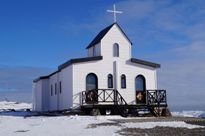 o the reopening ceremony of the Chapel of Santa Maria Reina de la Paz located at Villa Las Estrellas, the largest Chilean town in Antarctica. The Chaplain of the Unity Group Commander (SR) Juan Fuentes, blessed the new premises.
o the reopening ceremony of the Chapel of Santa Maria Reina de la Paz located at Villa Las Estrellas, the largest Chilean town in Antarctica. The Chaplain of the Unity Group Commander (SR) Juan Fuentes, blessed the new premises.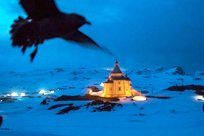 Interesting article pubblished on the New York Times by Ernesto Molina, a Chilean scientist, walking above the Russian Orthodox Church of the Holy Trinity, overlooking the Russian Antarctic base.
Interesting article pubblished on the New York Times by Ernesto Molina, a Chilean scientist, walking above the Russian Orthodox Church of the Holy Trinity, overlooking the Russian Antarctic base.
 There’s a saying about there being no God in Antarctica but from this summer there will also be fewer priests. America’s National Science Foundation has told Christchurch’s Catholic Diocese in NZ it no longer needs local priests on the ice. It was a sad development, but inevitable, says Father Dan Doyle (pic aside), who had been to Antarctica himself 14 times since 1984, and it was an amazing experience for the clergy.
There’s a saying about there being no God in Antarctica but from this summer there will also be fewer priests. America’s National Science Foundation has told Christchurch’s Catholic Diocese in NZ it no longer needs local priests on the ice. It was a sad development, but inevitable, says Father Dan Doyle (pic aside), who had been to Antarctica himself 14 times since 1984, and it was an amazing experience for the clergy.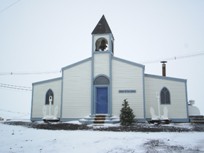 Better communications and internet connections meant people were less isolated while working in Antarctica and the drop-off was noticeable in the past five or six years. When I first went there 30 years ago there was no outside contact except ham radio or a two-minute phone call every few months, Father Doyle said
Better communications and internet connections meant people were less isolated while working in Antarctica and the drop-off was noticeable in the past five or six years. When I first went there 30 years ago there was no outside contact except ham radio or a two-minute phone call every few months, Father Doyle said Lieutenant Colonel Franco Colombo, tell us about his four past seasons in Antarctica in the wake of the Italian Expedition campaigns.
Lieutenant Colonel Franco Colombo, tell us about his four past seasons in Antarctica in the wake of the Italian Expedition campaigns.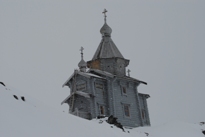 Our website and in particular this page dedicated to the Churches in Antarctica is now home of a very special reportage from a very special guest, the Mayor of Uvarovo City, Tambov Oblast, Russia.
Our website and in particular this page dedicated to the Churches in Antarctica is now home of a very special reportage from a very special guest, the Mayor of Uvarovo City, Tambov Oblast, Russia.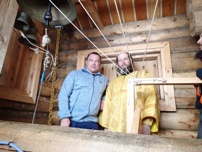 e WAP pages. As the mayor of this City, Alexander Kuznetsov did bring with him, on his way to Antarctica, the Tambov “Mother of God” and “St. Pitirim” icons to be presented to the Holy Trinity Church, the only Russian Orthodox Church in Antarctica.
e WAP pages. As the mayor of this City, Alexander Kuznetsov did bring with him, on his way to Antarctica, the Tambov “Mother of God” and “St. Pitirim” icons to be presented to the Holy Trinity Church, the only Russian Orthodox Church in Antarctica.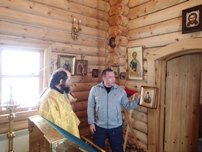 I have got a very great impression of the form of the temple and the conversation with the priest I had. We climbed up a small hill on which stands the temple, in a deep snow, and it was not easy. While the Church bells were ringing. It was very symbolic that we, overcoming the hard way, were in front to this miracle. The “Rector” invited us to the bell tower and allowed supervised also ring the bell.
I have got a very great impression of the form of the temple and the conversation with the priest I had. We climbed up a small hill on which stands the temple, in a deep snow, and it was not easy. While the Church bells were ringing. It was very symbolic that we, overcoming the hard way, were in front to this miracle. The “Rector” invited us to the bell tower and allowed supervised also ring the bell.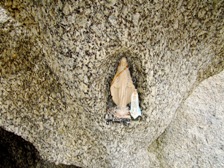 Thanks to Max IAØMZ who has taken a break to walk to the site where the statue of the Virgin is looking at the Italian Mario Zucchelli Station (MZS). We wish some better location for the Mother of Lord, perhaps one day …who knows, someone will turn our dream into a reality and we’ll have a small Chapel at the Italian Scientific site in Antarctica, where to thank God for protecting us.
Thanks to Max IAØMZ who has taken a break to walk to the site where the statue of the Virgin is looking at the Italian Mario Zucchelli Station (MZS). We wish some better location for the Mother of Lord, perhaps one day …who knows, someone will turn our dream into a reality and we’ll have a small Chapel at the Italian Scientific site in Antarctica, where to thank God for protecting us. Mauro Spreafico, made a small altar beneath a rocky outcrop where they put a small statue of the Virgin who had brought from Italy and there, used to meet the Madonna in prayer …. She is always there, for many years now, under a rock.
Mauro Spreafico, made a small altar beneath a rocky outcrop where they put a small statue of the Virgin who had brought from Italy and there, used to meet the Madonna in prayer …. She is always there, for many years now, under a rock.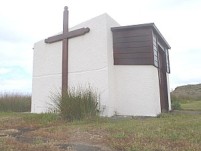 On the TAAF territories administered by the French authorities , freed from any religious affiliation, it is easily surprised to see a chapel present on each Base. This one on Amsterdam Island is tiny but charming, the Virgin Mary stands on her throne on a small altar. It is regularly frequented on Sunday. A few meters away, a bench invites to rest in the wind looking at the sea, and the bench of the chapel is the best observatory based, one could find.
On the TAAF territories administered by the French authorities , freed from any religious affiliation, it is easily surprised to see a chapel present on each Base. This one on Amsterdam Island is tiny but charming, the Virgin Mary stands on her throne on a small altar. It is regularly frequented on Sunday. A few meters away, a bench invites to rest in the wind looking at the sea, and the bench of the chapel is the best observatory based, one could find. Last Jan. 3rd 2013, with the presence of the priest Marcelo Lopez, and the whole Team of the 44th overwintering campaign,
Last Jan. 3rd 2013, with the presence of the priest Marcelo Lopez, and the whole Team of the 44th overwintering campaign,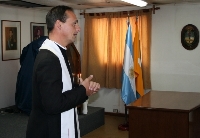
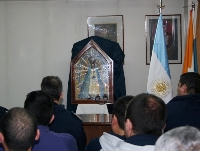


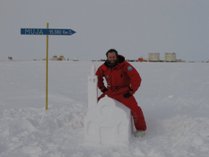
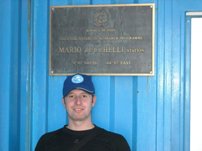 every day, aerosol atmospheric samplings, snow and precipitations, observing and record data weather.
every day, aerosol atmospheric samplings, snow and precipitations, observing and record data weather. While WAP hasn’t lost the hope, about the project of building a small Chapel at the Italian Mario Zucchelli Station in the settlement of Terra Nova Bay-Antarctica, we are pleased to see that other Countries are honoring their Antarctic sites of cult with polar emission and covers.
While WAP hasn’t lost the hope, about the project of building a small Chapel at the Italian Mario Zucchelli Station in the settlement of Terra Nova Bay-Antarctica, we are pleased to see that other Countries are honoring their Antarctic sites of cult with polar emission and covers.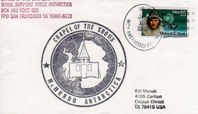
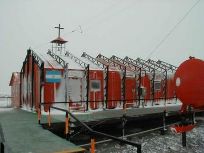 It was the 16th of April 1996 at Marambio Base when his Reverend Excellence the Military Bishop of the Argentine Republic, Monsignor D. Norberto Eugene Martina in solemn Pontifical, came to this Antarctic Station to bless and inaugurate the Oratory of the Cha
It was the 16th of April 1996 at Marambio Base when his Reverend Excellence the Military Bishop of the Argentine Republic, Monsignor D. Norberto Eugene Martina in solemn Pontifical, came to this Antarctic Station to bless and inaugurate the Oratory of the Cha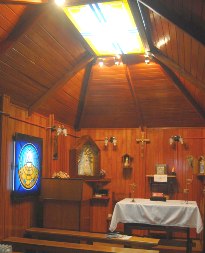 pel dedicated to the Santísima Virgen de Luján.
pel dedicated to the Santísima Virgen de Luján.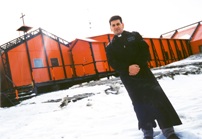 Force’s General staff, General Brigadier Juan Daniel Paulik and his wife Maria del Carmen Luxardo Garcia de Paulik.
Force’s General staff, General Brigadier Juan Daniel Paulik and his wife Maria del Carmen Luxardo Garcia de Paulik.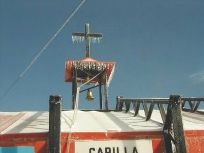
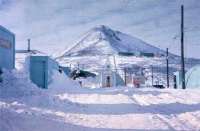 Are their different religions in Antarctica? All of the churches from your site appear to be Catholic. Are there conflicts or cults of any kind established in Antarctica?
Are their different religions in Antarctica? All of the churches from your site appear to be Catholic. Are there conflicts or cults of any kind established in Antarctica?
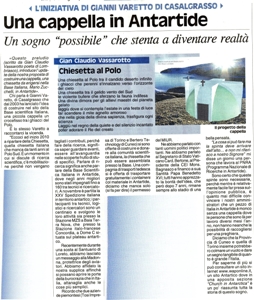 This is the title appeared on one of the
This is the title appeared on one of the  “Notre Dame des Vents” is the most southern France Church in the world.
“Notre Dame des Vents” is the most southern France Church in the world.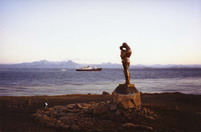

 Polar Antarctic Circle) until the Argentinean Belgrano 2 Base, the
Polar Antarctic Circle) until the Argentinean Belgrano 2 Base, the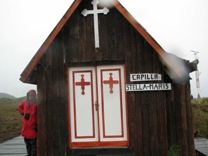
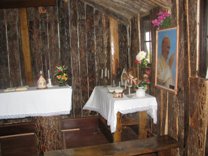 Horn, and who have lost thei
Horn, and who have lost thei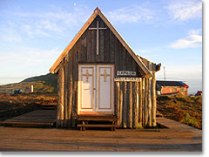 r lives down there.
r lives down there.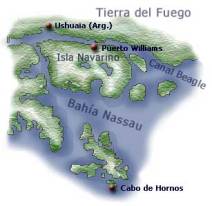 Tierra del Fuego is separated from the South America mainland by the Strait of Magellan.
Tierra del Fuego is separated from the South America mainland by the Strait of Magellan.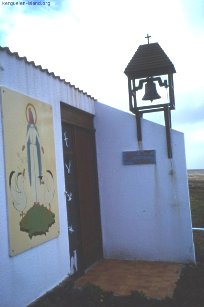 Well we have to assume that, not everybody know that on Possession Island (Crozet Archipelago) French Austral Territories, there is a Chapel called “Notre Dame des Oiseaux” (Our Lady of Birds).
Well we have to assume that, not everybody know that on Possession Island (Crozet Archipelago) French Austral Territories, there is a Chapel called “Notre Dame des Oiseaux” (Our Lady of Birds).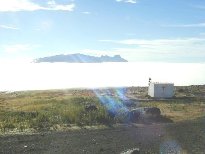
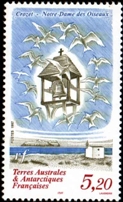


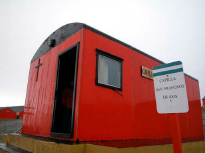 Continuing our virtual tour of the Antarctic Bases, speaded alla round the Icy Continent, we stop today at Esperanza Base, a nice Argentinean Station at Hope Bay. Thanks to Mr. Peter Sinke, a german friend who did sent this interesting pictures of a Chapel locater right here at 63° 32′ 42” South, 56° 59′ 46” West.
Continuing our virtual tour of the Antarctic Bases, speaded alla round the Icy Continent, we stop today at Esperanza Base, a nice Argentinean Station at Hope Bay. Thanks to Mr. Peter Sinke, a german friend who did sent this interesting pictures of a Chapel locater right here at 63° 32′ 42” South, 56° 59′ 46” West. 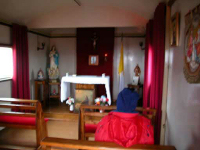
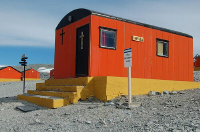 The Post Office sells stamps, and mail sent from here will reach any parts of the world in a relatively short time. When walking on the gravel roads through the base, one feels like to be really in a small town. The base has also a little Museum, an infirmary, 13 housing buildings, and a graveyard. The Chapel shown in the pictures is the one at Esperanza Base, and it is dedicated to San Francesco de Asis. It may not be the smallest chapel in the world but must be one of the most remote, and for sure it is the most Sothern one dedicated to S. Francesco. TNX Peter Sinke
The Post Office sells stamps, and mail sent from here will reach any parts of the world in a relatively short time. When walking on the gravel roads through the base, one feels like to be really in a small town. The base has also a little Museum, an infirmary, 13 housing buildings, and a graveyard. The Chapel shown in the pictures is the one at Esperanza Base, and it is dedicated to San Francesco de Asis. It may not be the smallest chapel in the world but must be one of the most remote, and for sure it is the most Sothern one dedicated to S. Francesco. TNX Peter Sinke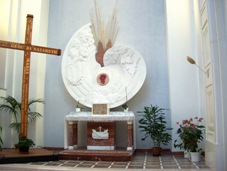 It was 5 years ago when WAP did launch the idea to build a Catholic Church in the area of the Italian Base MZS, at Terra Nova Bay, Antarctica.
It was 5 years ago when WAP did launch the idea to build a Catholic Church in the area of the Italian Base MZS, at Terra Nova Bay, Antarctica.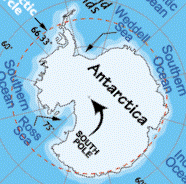
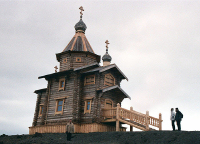 The Russian Orthodox Church is so concerned about the spiritual well-being of workers in Antarctica that it is sending them a flat pack church and a priest. Here is the story:
The Russian Orthodox Church is so concerned about the spiritual well-being of workers in Antarctica that it is sending them a flat pack church and a priest. Here is the story: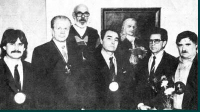 So the Patriarch proposed to build a Russian orthodox church at one of the Russian Antarctic stations. This choice was in full conformity with the Russian historical traditions. The place for construction of the church was selected at Bellingshausen station on King George Island. The Creative workshop of the Architect Anisiforov (First Left at the B&W pic on the R) designed the church. A group of Siberian architects won a national competition to design the church. They built it out of Altay cedar wood, which is considered a precious material, and incorporated 30 types of timber into it – a feature of old Russian churches.
So the Patriarch proposed to build a Russian orthodox church at one of the Russian Antarctic stations. This choice was in full conformity with the Russian historical traditions. The place for construction of the church was selected at Bellingshausen station on King George Island. The Creative workshop of the Architect Anisiforov (First Left at the B&W pic on the R) designed the church. A group of Siberian architects won a national competition to design the church. They built it out of Altay cedar wood, which is considered a precious material, and incorporated 30 types of timber into it – a feature of old Russian churches.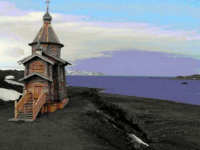
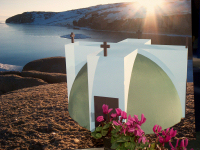
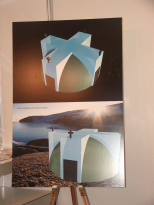
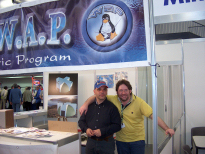
 The use of bio-technology is more a modern need rather than a nowadays fashion. The project of building a New Church
The use of bio-technology is more a modern need rather than a nowadays fashion. The project of building a New Church 
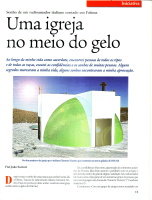
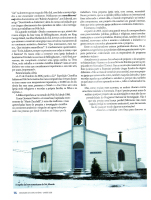
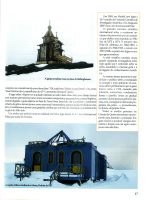 Santo Antonio”
Santo Antonio”
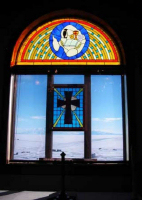 Picture on the left
Picture on the left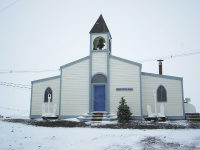 Mr. La Count described for the group the construction of the new chapel and recalled how volunteers had erected the station’s earlier Chapels
Mr. La Count described for the group the construction of the new chapel and recalled how volunteers had erected the station’s earlier Chapels